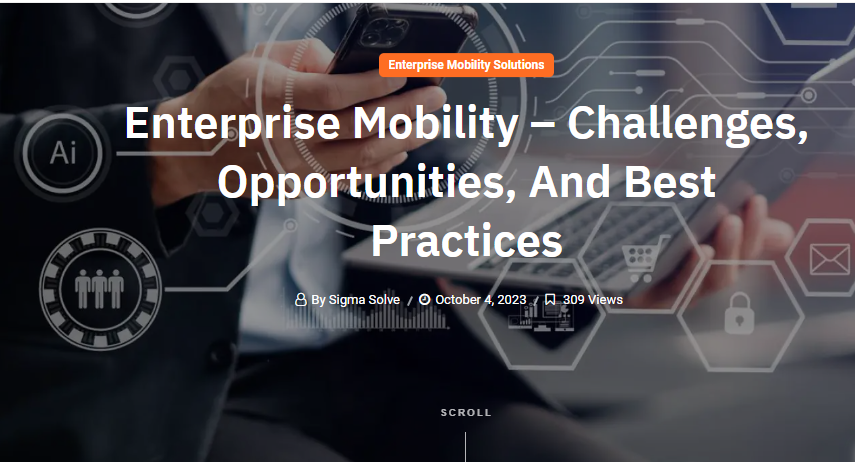Sigma Solve’s solutions revolutionize business processes and empower enterprises to adapt, grow, and scale new heights.
Synopsis:
As an IT company, we often encounter the question of whether digitization is helpful to humanity or whether it is working against us. Is there any definite answer? It depends on how you use digitization and what you use it for. In spite of this perplexity, enterprise mobility solutions have been empowering businesses and the working class alike.
Mobile technologies are enablers of multitasking. It has stimulated productivity, provided impetus to flawless collaborations, and facilitated swift decision-making. On top of that, enterprise mobility has allowed businesses to gain a competitive edge, providing enhanced customer experiences.
What is Enterprise Mobility?
Enterprise mobility is an approach in which an organization provides a suite of systems and services to its employees to access data and processes securely and work independently of the office environment without hampering productivity.
Overview:
There is no denying that mobile penetration has been unprecedented, and the rise of mobile technology is both incredible and beneficial. Even statistics give credence to the fact that employee productivity has risen by 36 to 40%, and almost 70% of organizations have invested in a remote workforce. The essence of digital transformation can be recognized because, according to the forecast, the enterprise mobility market will grow to $63.6 billion by 2026.
Nonetheless, businesses must eliminate the obstacles by addressing the challenges of integrating mobility solutions and utilizing them efficiently and successfully. This blog evaluates the challenges, enterprise-level efforts to resolve them, and deploying the best practices to ensure a smoother transition and greater returns.
Today, enterprises have sustainable growth at their core. Recognizing the mobility challenges, identifying the opportunities, and deploying best practices help businesses utilize enterprise mobility solutions to their full potential.
Challenges in Transforming Businesses through Mobility Solutions
Security Concerns:
Digital transformation does bring security-related challenges. Enterprise mobility solutions are not exceptional. Enterprises providing data access to personal devices could be risky. There is a heightened possibility of a data breach. Encrypting personal devices is also challenging.
Data Management:
The scale of mobile penetration has resulted in a massive pool of data. Storing these data, compartmentalizing them, and accessing them with authorization requires a complex architecture. Moreover, managing such architecture itself is challenging and resource-consuming.
Compatibility:
Old technologies, operating systems, and devices become obsolete with the latest technologies. Maintaining the compatibility of the devices and installed applications for streamlined performance is a major challenge for businesses.
User Experience:
Ensuring consistent corporate data access for employees in a user-friendly environment is daunting. Interface optimization across devices and their capabilities is critical for enhanced performance. There could be a more cost-effective solution.
Cost Management:
Building a sustainable architecture, acquiring compatible devices, mobile app development, and building data servers demand considerable financial investment. Calculating expenses against the return on investment may severely affect the annual budget.
Regulatory Compliance:
The regulatory framework is tightening each day. Governments across the globe pursue legal frameworks to protect personal data. Navigating through a compliance regime is complex. Ensuring employees observe norms and privacy laws is costly and exhausting for businesses.
System Modernization:
Digital transformation seeks to upgrade legacy systems by integrating enterprise mobility solutions. However, this homogenization can be complicated. Ensuring systems’ consistency while developing constant data synchronization in real time is complicated and challenging.
Scalability:
Preparing the legacy systems to accommodate more tasks without affecting performance presents critical operational issues. Making the existing system accessible to more devices, apps, and data may result in a breakdown of the system. Hence, improving scalability is a challenge.
Adaptability:
Adapting to new processes designed using mobility solutions poses a potential threat to operations. Ensuring impeccable adaptability requires a considerable amount of training for employees. As a result, performance slows down, further delaying the upgrade of the new system.
Bottom line:
Enterprise mobility solutions will shape the future of this digital world. Therefore, businesses must identify roadblocks and, ideally, should develop custom solutions by grabbing opportunities.
Sigma Solve’s mobility solutions provide AI and ML-powered digital transformation solutions, including mobile solutions. Learn more about how our enterprise mobility solutions revolutionize business processes and empower enterprises to adapt, grow, and scale new heights.
For more info: https://sigmasolve.com/enterprise-mobility-challenges-opportunities-and-best-practices/


